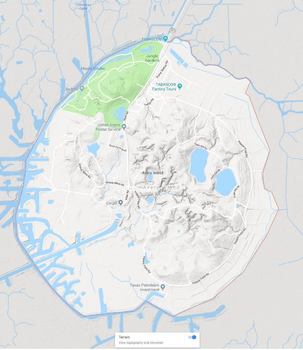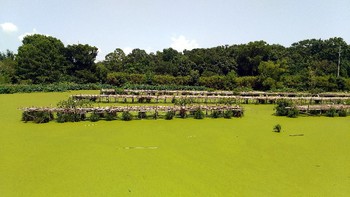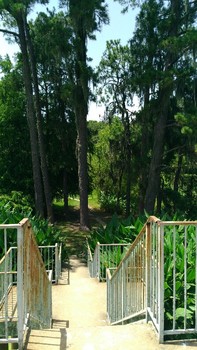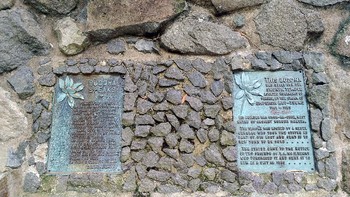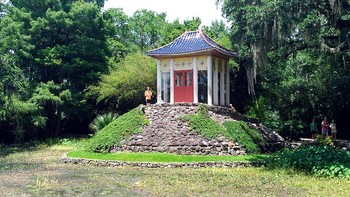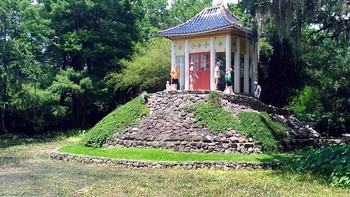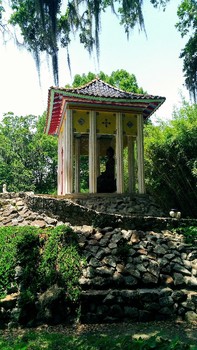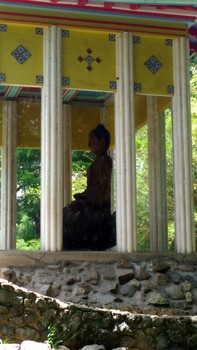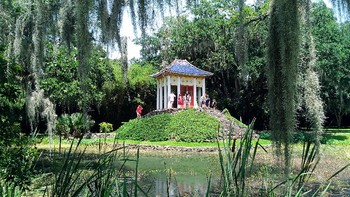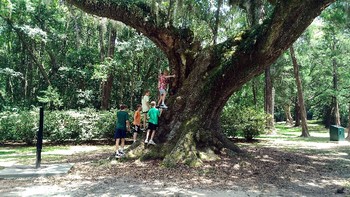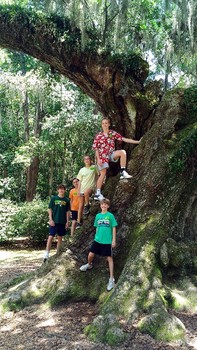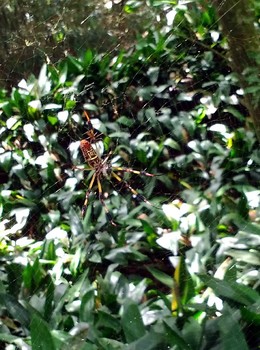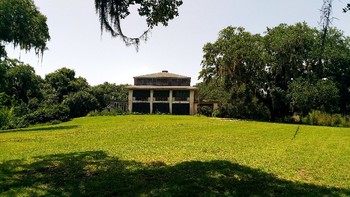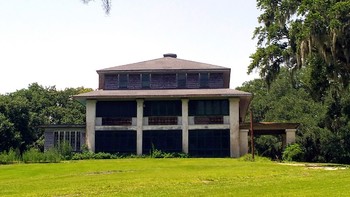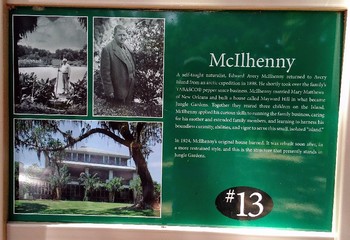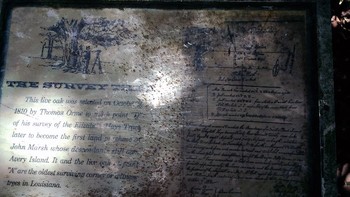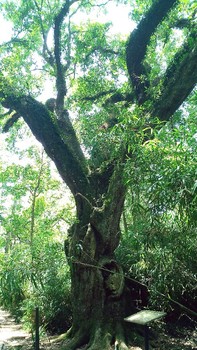During a day-trip to Avery Island we learned there’s much more to this south Louisiana curiosity than just hot sauce. There are two paid attractions on Avery Island: 1) Tours of the Tabasco factory (self-guided ~$5.50 each, more for guided group tours) and 2) Driving tour of the Jungle Gardens (additional $7 per person). Fees are for adults. There are slight discounts for seniors and young children.
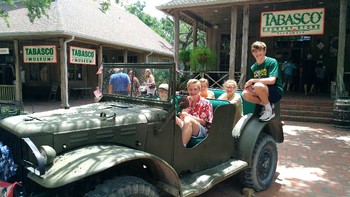
Jeep photo opp for our kids
Our trip was quite enjoyable but the above suggestions could make it better. One benefit we did enjoy were light crowds. I think a visit during the cooler seasons might experience larger crowds.
Location
Avery island is only a 1-1/2 hour drive from Baton Rouge. From interstate 10 in Lafayette we traveled south on US Hwy. 90 to New Iberia, and then almost 6 miles southwest on Hwy. 329 to Avery Island.
What Makes it Special
I particularly enjoyed this visit to Avery Island because there is are so many overlapping stories to tell about this place and others nearby. If you think this is only about hot sauce, you’ve missed out.
One of Louisiana’s “Five Gems”
As a resident of south Louisiana for over 17 years I was aware of the concept of “salt domes” and the rich geological amenities of our coast, but until I began researching for this Avery Island trip I didn’t grasp how cool and curious it is. There are five historically noted salt domes spaced nearly equidistantly in a line along Louisiana’s coast. In fact there are many along the Gulf coast states from Texas to Florida, and also another band across north Louisiana as well, but these five are particularly outstanding, noted by early explorers and surveyors during Louisiana’s Spanish period. They are from northwest to southeast:
- Jefferson Island
- Avery Island
- Weeks Island
- Cote Blache Island
- Belle Island
Attractions
Tourist attractions occur on several of these, including the estate of Joseph Jefferson and his Rip Van Winkle gardens, The Tabasco operation and Jungle Gardens on Avery Island, and a private hunting club and retreat center on Belle Island.
There is a fascinating history of the exploration of these islands, which rise as mounds above the surrounding marsh, lakes, and bayous. Googling each of these island names yields links to historical documentation and information about natural resources including salt mining and oil and gas extraction.
Tabasco Tour
We purchased tickets online in advance, printing our receipts and bringing them with us. You may also purchase on-site, potentially waiting in line. Even if you buy in advance online you still must provide your receipt to the ticket window clerk and she’ll exchange them for the admission passes - stickers you affix to your shirt. There are eight stops to the tour. After securing admission you proceed to “station 1” viewing the museum exhibits. It’s interesting to learn of the history of the island, the families who have inhabited it, and of the building of the Tabasco sauce business.
Much of this is a walking tour. “station 2” is a hike through a small greenhouse containing a few representative pepper plants. They’re all carefully out of reach so that visitor’s cannot pick a fruit to take home and plant the seeds for themselves. Next is an exhibit depicting the barrel warehouse where the mash is cured in oak casks.
Exhibit 4 involves retracing your steps and continuing to the other side of the factory to observe the blending room. We took the stairs (or a small elevator) to the 2nd floor where you look through plexiglass at the production floor. It’s a bunch of mixing vats where the pepper mash is mixed with vinegar. As I mentioned earlier, we visited on a Friday which was a holiday, so there were no employees doing anything on the production floor.
You retrace your steps back downstairs and then continue through the rest of the bottling factory. There are additional museum exhibits and interpretive displays, describing what’s going on and explaining the diversity of flavors, products and marketing efforts. It is quite interesting, and would be more so if the factory was in production. There is a product tasting table at the end, not open the day we visited. That’s okay. We all received sample bottles of three different flavors of Tabasco sauce at the ticket counter. And, Tabasco sauce isn’t exactly ice cream.
Jungle Gardens
Avery Island covers approximately 2,200 acres and about 170 have been set aside as botanical gardens and wildlife habitat. The gardens skirt the northwest side of the island along bayou Petite Anse or “little cove”, which was also the original name of the island but soon changed to “Avery” (a family name) by a new family member by marriage, who assumed operations of the sugar cane plantation. This occurred before the McIlhenny’s and pepper sauce. In fact, the first proposed name for the pepper sauce was “Petite Anse Sauce”, but this was rejected in favor of Tabasco, the name of a hot pepper from the Mexican state of Tabasco.
The jungle gardens tour offers a self-driving tour of the gardens on a gravel loop road. There are numerous pull-offs along the route offering opportunities to hike trails, sit at picnic tables, view the Buddha shrine, and see the specimen oak trees. According to the plaque, the Survey Oak and another ancient oak on the island are the two oldest “witness trees” serving as land survey corner points throughout the entire state. They were present in 1810 when “Petite Anse” island was surveyed. Think of all of the tropical storms they’ve survived!
There are lagoons along the route where we spotted a small gator, and I suspect the waters provide a layover for migratory waterfowl in season. The island is an e-bird hotspot where over 150 species have been recorded. The “bird island” features a man-made heron rookery. Another key attraction is the large Buddha which dates from early 1100’s China. According to the plaque at the shrine, this Buddha was stolen and turned up in New York. Several men - friends of Mr. McIlhenny - acquired it and gifted it to him in 1936. He installed it in a shrine in the gardens overlooking a lagoon featuring an oriental arched stone bridge. A grand estate home of E.A. McIlhenny dating from 1925 stands, but is looks to be in disrepair and is not open for public viewing.
View the full resolution Google photo album. 
As you can see from the photos, ours was a family trip including five teens and tweens. We all had a good time; I feel the McIlhenny’s have succeeded providing a terrific, authentic Louisiana attraction. I guess I hoped there would be an opportunity to see the growing fields, but that is available only to guide-led group tours.
Rip Van Winkle
This tour of Avery Island has spurred my interest to visit other south Louisiana heritage attractions. On another trip we will visit Jefferson Island - another salt dome - and it’s Lake Piegneur. Here, and also at Belle Island further southeast, the mineral extraction activities have led to disasters which left their mark on south Louisiana culture and industry. Like Avery, Jefferson Island also has a botanical garden and the manor house of actor Joseph Jefferson is restored, open for tours and also as a B&B. See more at Rip Van Winkle Gardens,

